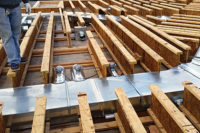In 2014, the state of California implemented regulations limiting the use of bypass ducts — short ducts placed between the supply plenum and return air plenum in a forced-air system — in residential zoned heating and cooling systems. The move came as part of California’s Title 24 legislation, which did not completely ban bypass ducts, but significantly limited their usage in newly constructed buildings.
However, a new study conducted by Air-Conditioning, Heating, and Refrigeration Institute’s (AHRI’s) Zone Control System Technology (ZCST) product section revealed that bypass-type single-stage cooling zoning systems may positively influence an HVAC system’s EER.
EWC Controls Inc. designed and managed the project of installing a new zone system into an independent test home in Rancho Cordova, California. The system complied with both ACCA Manual Zr and the Performance Zoning Standard in Title 24, 2013, which allows a bypass so long as 350 cfm per ton return airflow is confirmed by a Home Energy Rating System (HERS) rater.
The contractor for the project replaced the entire duct system and installed a new zone control panel compatible with the existing single-stage HVAC system, but capable of multi-stage operation. The contractor also installed a new bypass system and new zone dampers.
A professional engineering firm tested the performance of the zoned cooling system after the completion of the project on July 17, 2013. The results showed no negative impact on the cooling system EER due to the bypass airflow volume and, in fact, revealed a positive influence to the cooling system’s EER during zoned operation. A second test was conducted by a separate engineering firm on July 29, 2013, and found the same results.
INDUSTRY REACTS
These results are beneficial to manufacturers who pushed for the study and support the validity and benefits of bypass products.
“The study confirms that zoning is a great technology,” said Tom Jackson, CEO, Jackson Systems LLC. “This proves the technology of the bypass does what it is supposed to do. When installed properly, it offers the user savings. The AHRI test is something we were excited to see because it is going to save us a lot of time in research and development. All manufacturers have to figure out what it really means, how to react, and what resources we are going to have to throw at this.”
Dick Foster, president of Zonefirst, believes the data from this study will be valuable for manufacturers and contractors.
“We [AHRI’s ZCST] conducted the study to justify the benefits of zoning and prove to ourselves, the industry, and everyone else that the CEC’s [California Energy Commission’s] findings were wrong,” he said. “That was the intent. The old study was not right, and we feel confident this study proves that. We would love to see a zoning credit put back in and eliminate the ban on the bypass. We have no qualms about discussing how to design the bypass or the rest of the system.”
Joe Ramunni, an HVAC forced-air zoning specialist, said if a system is designed with zoning in mind, the effects on performance — specifically EER — will be minimal.
“The improvement in overall system effectiveness would either balance out any efficiency losses or possibly allow an EER increase due to the reduced seasonal run time,” he said. “Zoning allows the system to focus on the area of the structure that is under load while not over-conditioning those that are not. This focused performance can, if designed properly (minimal or no bypass), provide increased Btu delivery where and when it’s needed. This, of course, depends upon how the system is operated in regards to the diversity and extremes of the set temperature desires of the end user.”
This latest AHRI study stands in contrast to a previous case study from July 2011. That study examined HVAC efficiency at 80 homes in the Sacramento-area built in 2007 or later.
Sixteen multiple or zoned split systems were examined, and the study determined the targeted cooling systems featured high cooling duct pressures, low-capacity efficiency, and high cooling fan wattage.
“The interesting thing was that the study the state of California did and this study both show how important proper installation is,” said Jackson. “The first one had poor ductwork and was poorly installed. It was a bad system to start. From a contractor standpoint, it reaffirms that quality installations are essential and have a huge impact on results. It has an impact on day-to-day operation.”
CONTRACTOR AWARENESS
For contractors, there is not a unilateral agreement on zoning and bypass dampers’ actual value and importance to the industry. While most agree they offer a great level of comfort, there are varying opinions.
“Bypass ducts are one of those items that should only be used as a last resort, in my opinion,” said David Richardson, curriculum developer and trainer at the National Comfort Institute (NCI). “Zoning is a wonderful accessory when optimal control of comfort is desired. It’s also a great way of handling large variations in load swings, such as with a single-story home over a basement. Though, when it comes to bypass dampers, if they can be avoided, they should.”
Matthew Pillius, owner and CEO of Royal Class Service in New Hudson, New York, said zoning undoubtedly makes a home more comfortable.
“There’s the belief that zoning can save a lot on equipment costs and still give a user some control over where to distribute heating and cooling in a space. The big money savings relies on the equipment. If the user has an old-school, two-story, colonial home, we used to install a system upstairs and a system downstairs, which would require two outdoor condensers, two indoor air handlers or furnaces, etc. By adding a little bit of shared ductwork and zone dampers, the system operates as one piece of equipment, and there is undoubtedly big savings in that.”
While zoning offers absolute user control, it also offers caveats, said Richardson.
“As with any other part of an HVAC system, a zone system has to be properly commissioned to assure air is making it to the intended areas of a building,” he said. “One of the biggest issues is when zoning is abused in its application or sold as a silver bullet. I have seen system capacities drastically undersized on zone systems in an attempt to cut costs. The belief is that both zones will rarely call at the same time, which is a bad assumption to make.”
Manufacturers generally don’t believe contractors pay much attention to studies like the one conducted by AHRI until they have a direct impact on them, and with Title 24 legislation firmly in place in California, effects of this study won’t be felt right away.
“I don’t know that contractors are all that aware of either study,” said Elijah Montgomery, product engineer, Jackson Systems. “Contractors in California are somewhat in tune with it, but I don’t think the rest of the country cares much. Unless it directly affects them, they simply won’t give it much thought. I know personally, for Jackson Systems, it caused us to do some things differently in regards to bypass. We have all come up with dampers or some other method of alleviating excess static pressure. All those things probably came about because of panic when we heard what California was doing. It caused us to do some reevaluation and find better ways to do bypass and make it simpler for contractors. As for right now, on a day-to-day basis, it won’t matter for contractors.”
Foster said the average industry contractor does not commission a system and make sure the airflow is right. “It’s not a skilled industry at balancing airflows,” he said. “Less than 2 percent of homes get inspected in California, and duct systems are generally lousy. Zoning makes a good system great and a lousy system worse.”
Jackson noted that while there is always a chance this study could have an effect on legislation in California, he doesn’t expect it.
“The legislature has demonstrated so far that it is hardheaded and not listening to industry professionals,” he said. “AHRI is a powerhouse in the industry, and when they kind of get blown off, at least for the foreseeable future, I don’t think California is going to change.”
Publication date: 3/21/2016
Want more HVAC industry news and information? Join The NEWS on Facebook, Twitter, and LinkedIn today!









